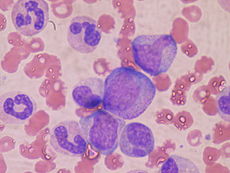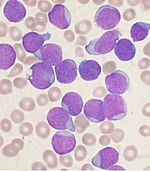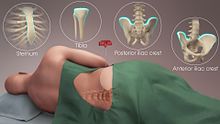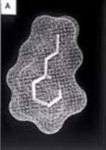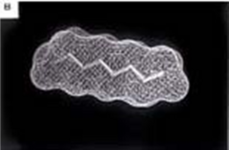| Bone marrow | |
|---|---|
| Details | |
| System | Immune system |
| Identifiers | |
| Latin | Medulla ossium |
| MeSH | D001853 |
| TA | A13.1.01.001 |
| FMA | 9608 |
Bone marrow is a semi-solid tissue which may be found within the spongy or cancellous portions of bones. In birds and mammals, bone marrow is the primary site of new blood cell production or hematopoiesis. It is composed of hematopoietic cells, marrow adipose tissue, and supportive stromal cells. In adult humans, bone marrow is primarily located in the ribs, vertebrae, sternum, and bones of the pelvis. On average, bone marrow constitutes 4% of the total body mass of humans; in an adult having 65 kilograms of mass (143 lb), bone marrow typically accounts for approximately 2.6 kilograms (5.7 lb).
Human marrow produces approximately 500 billion blood cells per day, which join the systemic circulation via permeable vasculature sinusoids within the medullary cavity. All types of hematopoietic cells, including both myeloid and lymphoid lineages, are created in bone marrow; however, lymphoid cells must migrate to other lymphoid organs (e.g. thymus) in order to complete maturation.
Bone marrow transplants can be conducted to treat severe diseases of the bone marrow, including certain forms of cancer such as leukemia. Additionally, bone marrow stem cells have been successfully transformed into functional neural cells, and can also potentially be used to treat illnesses such as inflammatory bowel disease.
Structure
The
composition of marrow is dynamic, as the mixture of cellular and
non-cellular components (connective tissue) shifts with age and in
response to systemic factors. In humans, marrow is colloquially
characterized as "red" or "yellow" marrow (Latin: medulla ossium rubra, Latin: medulla ossium flava, respectively) depending on the prevalence of hematopoetic cells vs fat cells. While the precise mechanisms underlying marrow regulation are not understood, compositional changes occur according to stereotypical patterns.
For example, a newborn baby's bones exclusively contain
hematopoietically active "red" marrow, and there is a progressive
conversion towards "yellow" marrow with age. In adults, red marrow is
found mainly in the central skeleton, such as the pelvis, sternum, cranium, ribs, vertebrae and scapulae, and variably found in the proximal epiphyseal ends of long bones such as the femur and humerus. In circumstances of chronic hypoxia, the body can convert yellow marrow back to red marrow to increase blood cell production.
Hematopoietic components
Hematopoietic precursor cells: promyelocyte in the center, two metamyelocytes next to it and band cells from a bone marrow aspirate.
At
the cellular level, the main functional component of bone marrow
includes the progenitor cells which are destined to mature into blood
and lymphoid cells. Marrow contains hematopoietic stem cells which give rise to the three classes of blood cells that are found in circulation: white blood cells (leukocytes), red blood cells (erythrocytes), and platelets (thrombocytes).
| Group | Cell type | Average fraction |
Reference range |
|---|---|---|---|
| Myelopoietic cells |
Myeloblasts | 0.9% | 0.2–1.5 |
| Promyelocytes | 3.3% | 2.1–4.1 | |
| Neutrophilic myelocytes | 12.7% | 8.2–15.7 | |
| Eosinophilic myelocytes | 0.8% | 0.2–1.3 | |
| Neutrophilic metamyelocytes | 15.9% | 9.6–24.6 | |
| Eosinophilic metamyelocytes | 1.2% | 0.4–2.2 | |
| Neutrophilic band cells | 12.4% | 9.5–15.3 | |
| Eosinophilic band cells | 0.9% | 0.2–2.4 | |
| Segmented neutrophils | 7.4% | 6.0–12.0 | |
| Segmented eosinophils | 0.5% | 0.0–1.3 | |
| Segmented basophils and mast cells | 0.1% | 0.0–0.2 | |
| Erythropoietic cells |
Pronormoblasts | 0.6% | 0.2–1.3 |
| Basophilic normoblasts | 1.4% | 0.5–2.4 | |
| Polychromatic normoblasts | 21.6% | 17.9–29.2 | |
| Orthochromatic normoblast | 2.0% | 0.4–4.6 | |
| Other cell types |
Megakaryocytes | < 0.1% | 0.0-0.4 |
| Plasma cells | 1.3% | 0.4-3.9 | |
| Reticular cells | 0.3% | 0.0-0.9 | |
| Lymphocytes | 16.2% | 11.1-23.2 | |
| Monocytes | 0.3% | 0.0-0.8 |
Stroma
The stroma of the bone marrow includes all tissue not directly involved in the marrow's primary function of hematopoiesis.
Stromal cells may be indirectly involved in hematopoiesis, providing a
microenvironment that influences the function and differentiation of
hematopoeietic cells. For instance, they generate colony stimulating factors, which have a significant effect on hematopoiesis. Cell types that constitute the bone marrow stroma include:
- fibroblasts (reticular connective tissue)
- macrophages, which contribute especially to red blood cell production, as they deliver iron for hemoglobin production.
- adipocytes (fat cells)
- osteoblasts (synthesize bone)
- osteoclasts (resorb bone)
- endothelial cells, which form the sinusoids. These derive from endothelial stem cells, which are also present in the bone marrow.
Function
Mesenchymal stem cells
The bone marrow stroma contains mesenchymal stem cells (MSCs), also known as marrow stromal cells. These are multipotent stem cells that can differentiate into a variety of cell types. MSCs have been shown to differentiate, in vitro or in vivo, into osteoblasts, chondrocytes, myocytes, marrow adipocytes and beta-pancreatic islets cells.
Bone marrow barrier
The blood vessels
of the bone marrow constitute a barrier, inhibiting immature blood
cells from leaving the marrow. Only mature blood cells contain the membrane proteins, such as aquaporin and glycophorin, that are required to attach to and pass the blood vessel endothelium. Hematopoietic stem cells may also cross the bone marrow barrier, and may thus be harvested from blood.
Lymphatic role
The red bone marrow is a key element of the lymphatic system, being one of the primary lymphoid organs that generate lymphocytes from immature hematopoietic progenitor cells. The bone marrow and thymus
constitute the primary lymphoid tissues involved in the production and
early selection of lymphocytes. Furthermore, bone marrow performs a valve-like function to prevent the backflow of lymphatic fluid in the lymphatic system.
Compartmentalization
Biological compartmentalization is evident within the bone marrow, in that certain cell types tend to aggregate in specific areas. For instance, erythrocytes, macrophages, and their precursors tend to gather around blood vessels, while granulocytes gather at the borders of the bone marrow.
As food
Animal bone marrow has been used in cuisine worldwide for millennia, such as the famed Milanese Ossobuco.
Clinical significance
Disease
The normal bone marrow architecture can be damaged or displaced by aplastic anemia, malignancies such as multiple myeloma, or infections such as tuberculosis,
leading to a decrease in the production of blood cells and blood
platelets. The bone marrow can also be affected by various forms of leukemia, which attacks its hematologic progenitor cells. Furthermore, exposure to radiation or chemotherapy will kill many of the rapidly dividing cells of the bone marrow, and will therefore result in a depressed immune system. Many of the symptoms of radiation poisoning are due to damage sustained by the bone marrow cells.
To diagnose diseases involving the bone marrow, a bone marrow aspiration is sometimes performed. This typically involves using a hollow needle to acquire a sample of red bone marrow from the crest of the ilium under general or local anesthesia.
Application of stem cells in therapeutics
Bone marrow derived stem cells have a wide array of application in regenerative medicine.
Imaging
Medical imaging may provide a limited amount of information regarding bone marrow. Plain film x-rays
pass through soft tissues such as marrow and do not provide
visualization, although any changes in the structure of the associated
bone may be detected. CT
imaging has somewhat better capacity for assessing the marrow cavity of
bones, although with low sensitivity and specificity. For example,
normal fatty "yellow" marrow in adult long bones is of low density (-30
to -100 Hounsfield units), between subcutaneous fat and soft tissue.
Tissue with increased cellular composition, such as normal "red" marrow
or cancer cells within the medullary cavity will measure variably higher
in density.
MRI
is more sensitive and specific for assessing bone composition. MRI
enables assessment of the average molecular composition of soft tissues,
and thus provides information regarding the relative fat content of
marrow. In adult humans, "yellow" fatty marrow is the dominant tissue in
bones, particularly in the (peripheral) appendicular skeleton. Because fat molecules have a high T1-relaxivity,
T1-weighted imaging sequences show "yellow" fatty marrow as bright
(hyperintense). Furthermore, normal fatty marrow loses signal on
fat-saturation sequences, in a similar pattern to subcutaneous fat.
When "yellow" fatty marrow becomes replaced by tissue with more
cellular composition, this change is apparent as decreased brightness on
T1-weighted sequences. Both normal "red" marrow and pathologic marrow
lesions (such as cancer) are darker than "yellow" marrow on T1-weight
sequences, although can often be distinguished by comparison with the MR
signal intensity of adjacent soft tissues. Normal "red" marrow is
typically equivalent or brighter than skeletal muscle or intervertebral
disc on T1-weighted sequences.
Fatty marrow change, the inverse of red marrow hyperplasia, can occur with normal aging, though it can also be seen with certain treatments such as radiation therapy. Diffuse marrow T1 hypointensity without contrast enhancement or cortical discontinuity suggests red marrow conversion or myelofibrosis. Falsely normal marrow on T1 can be seen with diffuse multiple myeloma or leukemic
infiltration when the water to fat ratio is not sufficiently altered,
as may be seen with lower grade tumors or earlier in the disease
process.
Histology
A Wright's-stained bone marrow aspirate smear from a patient with leukemia.
Bone marrow examination is the pathologic analysis of samples of bone marrow obtained via biopsy
and bone marrow aspiration. Bone marrow examination is used in the
diagnosis of a number of conditions, including leukemia, multiple
myeloma, anemia, and pancytopenia. The bone marrow produces the cellular elements of the blood, including platelets, red blood cells and white blood cells. While much information can be gleaned by testing the blood itself (drawn from a vein by phlebotomy),
it is sometimes necessary to examine the source of the blood cells in
the bone marrow to obtain more information on hematopoiesis; this is the
role of bone marrow aspiration and biopsy.
The ratio between myeloid series and erythroid cells is relevant to bone marrow function, and also to diseases of the bone marrow and peripheral blood, such as leukemia and anemia. The normal myeloid-to-erythroid ratio is around 3:1; this ratio may increase in myelogenous leukemias, decrease in polycythemias, and reverse in cases of thalassemia.
Donation and transplantation
A bone marrow harvest in progress.
The preferred sites for the procedure
In a bone marrow transplant,
hematopoietic stem cells are removed from a person and infused into
another person (allogenic) or into the same person at a later time
(autologous). If the donor and recipient are compatible, these infused
cells will then travel to the bone marrow and initiate blood cell
production. Transplantation from one person to another is conducted for
the treatment of severe bone marrow diseases, such as congenital
defects, autoimmune diseases or malignancies. The patient's own marrow
is first killed off with drugs or radiation, and then the new stem cells are introduced. Before radiation therapy or chemotherapy in cases of cancer,
some of the patient's hematopoietic stem cells are sometimes harvested
and later infused back when the therapy is finished to restore the
immune system.
Bone marrow stem cells can be induced to become neural cells to treat neurological illnesses, and can also potentially be used for the treatment of other illnesses, such as inflammatory bowel disease. In 2013, following a clinical trial, scientists proposed that bone marrow transplantation could be used to treat HIV in conjunction with antiretroviral drugs; however, it was later found that HIV remained in the bodies of the test subjects.
Harvesting
The stem cells are typically harvested directly from the red marrow in the iliac crest, often under general anesthesia.
The procedure is minimally invasive and does not require stitches
afterwards. Depending on the donor's health and reaction to the
procedure, the actual harvesting can be an outpatient procedure, or can require 1–2 days of recovery in the hospital.
Another option is to administer certain drugs that stimulate the
release of stem cells from the bone marrow into circulating blood. An intravenous catheter
is inserted into the donor's arm, and the stem cells are then filtered
out of the blood. This procedure is similar to that used in blood or
platelet donation. In adults, bone marrow may also be taken from the sternum, while the tibia is often used when taking samples from infants. In newborns, stem cells may be retrieved from the umbilical cord.
Fossil record
Bone marrow may have first evolved in Eusthenopteron, a species of prehistoric fish with close links to early tetrapods.
The earliest fossilised evidence of bone marrow was discovered in 2014 in Eusthenopteron, a lobe-finned fish which lived during the Devonian period approximately 370 million years ago. Scientists from Uppsala University and the European Synchrotron Radiation Facility used X-ray synchrotron microtomography to study the fossilised interior of the skeleton's humerus, finding organised tubular structures akin to modern vertebrate bone marrow. Eusthenopteron is closely related to the early tetrapods, which ultimately evolved into the land-dwelling mammals and lizards of the present day.
